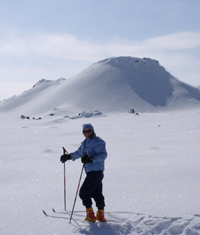For those willing to brave the cold, winter may be one of the best times to visit the vast desert wilderness known as Craters of the Moon National Monument and Preserve.
In the height of summer, the heat and ruggedness of Craters' otherworldly landscape can be tough on both one's body and the soles of one's boots. But winter snows serve to soften the area's harsh character. Seared cinder cones and fractured lava flows become perfectly suited to a memorable backcountry skiing adventure.
Winter recreational options are plentiful at the sprawling 750,000-acre monument northeast of Carey. They're also a perfect alternative for adventurous Blaine County snow enthusiasts looking for a different environment.
"It's such a unique experience," said Picabo resident Ted Stout, a ranger and chief of interpretation at the monument. "Everything is black and white."
One of the most popular winter pastimes at Craters is the over seven miles of groomed nordic skiing available from mid-December through February in most years. Gliding past twisted juniper trees plastered in snow and rime ice and around dormant volcanic cones in the absolute silence of winter is an experience skiers don't soon forget.
The winter trail is groomed as snowpack and staffing allow.
Even on the best of days, crowds are generally light along the monument's snow-covered loop road, whose groomed surface winds past some of Craters' most visible volcanic features. They include North Crater, Paisley Cone, the Splatter Cones, Inferno Cone and the Devil's Orchard.
For those wishing to head off the groomed trail into untracked powder, these silent sentinels in the desert provide excellent snowshoeing or telemark ski turning opportunities.
"Where else can you scale a volcanic peak in the winter?" Stout asked.
During the winter months, the monument's intense quiet and vast unspoiled distances may convince visitors they have the wonderful park all to themselves.
Even better, the monument doesn't charge visitors an entrance fee when the park's loop road is closed during the winter.
Parking is available at the north end of the monument next to the Craters visitor center, which is open daily from 8 a.m. until 4:30 p.m., except during winter holidays. The entrance to the visitor center parking lot is about 25 miles northeast of Carey along U.S. Highway 20.
Winter visitors should come prepared for the area's cold and often windy weather. Keep in mind that conditions can change rapidly, meaning skiers should be prepared for the worst.
According to park information, average high temperature in January is 29 degrees Fahrenheit and the average low is 10 degrees. Even on the best of days, wind is common. Visitors should carry extra clothing, water and a snack when heading out into Craters.
People should also know their abilities and not ski so far out that they become exhausted. Skiers and snowshoers should be especially cautious if they leave the groomed track and enter the more remote and seldom-visited areas of the monument, such as the 43,243-acre Craters of the Moon Wilderness Area. Keep in mind that the surface of the lava beneath the snow is very uneven and may conceal cracks and sharp rocks.
Because dogs can tear up the groomed track and detract from the skiing experience of others, National Park Service rules bar your canine friends from the groomed trail. Dogs can also scare the area's wintering wildlife.
Experience snowbound Craters of the Moon
Though there are many activities one can pursue at Craters during the winter, first-time visitors may wish to explore the park guided by a ranger. Here are some of the ranger-led activities scheduled this winter:
· Winter Ecology Workshops: 9:30 a.m. to 3 p.m. on the Saturdays of Jan. 3, 10, 17, 24, 31 and Feb. 14 and 21. Explore a different side of Craters of the Moon on a ranger-guided winter ecology snowshoe walk and workshop. The workshop starts with a 45-60 minute classroom session followed by several hours out in the park on snowshoes. Snowshoes are available for use and there is no charge for these events. Reservations are required and participants need to be at least 10 years of age for this moderately strenuous walk. Call early to sign up for these popular excursions.
· Snow School: Wednesdays and Thursdays in January and February.
Bring your students to Craters for an educational snowshoe trek. Participants will snowshoe with a ranger and learn about how wildlife adapts to winter conditions. The park has enough snowshoes for about 30 students and the walks are suitable for third graders and up. Call for more information or to schedule a class visit.
For additional park information, call the visitor center at (208) 527-1300 or log on to the park's Web site at http://www.nps.gov/crmo/index.htm.


 Craters of the Moon allows for a variety of outdoor adventures, whether on skis or snowshoes.
Photo by
Craters of the Moon allows for a variety of outdoor adventures, whether on skis or snowshoes.
Photo by



































